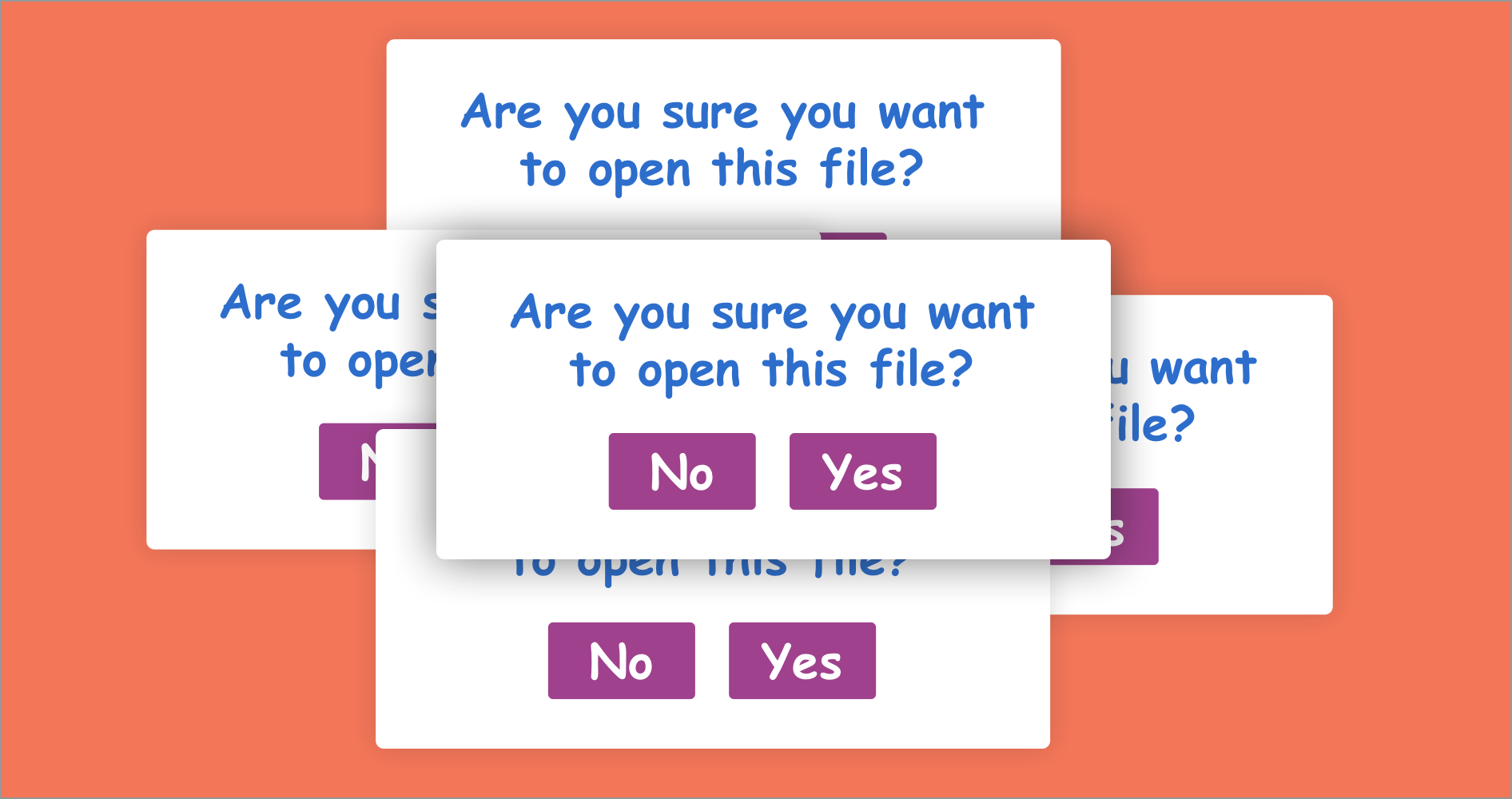Mechanical keyboard — considered one of the best types of keyboards due to its tactile feedback.
Ever watch people entering an elevator and repeatedly push the Up button? Or repeatedly push the pedestrian button at a street crossing? Or hit a refresh button many times because the loading bar keeps spinning and nothing happens?
What is missing in all these cases is feedback — some way of letting you know that what you did is working. Feedback acknowledges actions and shows results to keep people informed.
Early digital camera models did not provide any tactile or sound feedback when a picture was taken. Now, most of them produce a satisfying but fake shutter click when a photo was taken. Most smartphones produce a sound when you take a picture and a vibration when the phone is on silence too. But imagine how shallow and misleading it would be if there would be no feedback.

"Feedback is a central feature of life. The process of feedback governs how we grow, respond to stress and challenge, and regulate factors such as body temperature, blood pressure and cholesterol level. The mechanisms operate at every level, from the interaction of proteins in cells to the interaction of organisms in complex ecologies." — M. B. Hoagland and B. Dodson, The Way Life Works

Feedback is everywhere. Even in biology (or our bodies) use feedback to tell you that specific actions are wrong (regularly eating lousy food, getting flu, etc.) or right. With all the digital world being so advanced our body’s nervous system needs to feel feedback to send signals to our brain that things work.
This means that our designs should give clear responses on what is happening on the screen or with a certain action. And a user should not make an effort to understand that. Because if it is missing, it will be like trying to hit a target with a ball when you can’t see. But taking into account the importance of great feedback, it’s incredible how many companies ignore it. Or don’t invest too much in it.
Feedback must be immediate
Sometimes even a delay of a tenth of a second can cause confusion. If a delay is too long, people, most often, give up and move on. It is especially disappointing when you have a costly system or software, that solves a big problem, only to realise that what you did had no proper feedback system.
And you see it a lot in companies and even governments trying to save money on bulbs and sounds only to give us a poor end experience. You have all these weak signals, light flashes, and sounds that make noise and do not explain what to do next. Why did I receive feedback? What should I do next? Am I doing it right? What if things go wrong? And these type of questions pop up into a users mind. Whether the feedback is visual or as a sound.

Audio feedback
If the feedback is in the form of audio, you might not understand which device is making it. For example, one day my fire alarm was making a very infuriating beep every 10 minutes. And for three weeks I could not figure out where that sound was coming from. Until one day, by accident, I was near it and heard the noise. And apparently, the noise was a feedback telling me that the battery was low/dead. If the manufacturer thought about that in advance, that fire alarm could save someone’s life. The person who bought it, could have changed the battery on time with proper feedback.
Sounds are part of feedback systems that can save us from accidents or inform about an action:
- The click you hear when the toast pops up;
- The sound you hear when the printer cartridge is empty;
- The tiny sound when a door closes or does not shut properly;
- The rattle when things aren’t secured;
- The horn sound of a car;

Light (or visual) feedback
But if the feedback is in the form of light (a flash of red light), don’t forget that our sight is also limited. And sometimes we might miss it when we blink or did not catch it on time, unless we are watching at the right time and the right spot (hint: most of the times we don’t). Of course, giving here advice or recommendation is useless because it all depends on the context you are trying to create, but remember these quick tips:
- Interactive elements should be highlighted briefly when tapped;
- Progress indicators communicate the status of long-running operations (those endless and confusing spinning loaders);
- Animations help clarify the results of actions;

Painting with feedback
Feedback can be applied almost everywhere. For example, let’s say that you decided one day to paint your ceiling. This task is more difficult than it may seem. All ceilings are almost all the time white because while you paint it, you cant see where exactly you have painted and where not. So some spots remain, and you have to wait for it to dry and then notice the remaining parts. How to solve this problem? A helpful person invented a type of ceiling paint that goes pink when wet but goes white when dry. Unless the painter is colourblind, this solves the problem.

Poor feedback can be worse than no feedback
Why? Because it is distracting, misinforming and often, it may be irritating. For example, a dishwasher that signals at three in the morning that it finished washing can wake people up. But too much feedback can cause trouble also. Like the backseat driver who constantly tells you what to do in certain situations (for example, when you can’t see behind). Which sometimes is helpful, but then it becomes annoying.
Same way, like the backseat driver, applies to technology. Too much feedback, too many notifications, may make the user angry and “blind” to any future warnings, even if it is a critical one. Feedback is essential but not when it gets in the way of a calm and relaxing environment.

How it may go wrong
An important type of feedback is warning that something is wrong, or better, that something wrong is going to happen. For example, our laptops warn us when the battery is about to go down, and we need to recharge it. But we have to be careful not to offer too many notifications (warnings) that they become ignored by default.
For example, that pop up when the OS asks you “Are you sure you want to open this file?” and you click “Yes”. The problem is that these type of notifications may appear too often. And you might click so many times “Yes”, that at one moment the notification may be different. But you will click “Yes” anyways because you already trained your brain for that. Pavlov’s experiment at its best.

Electric vehicles and blind people
Sometimes, all we need, can’t be made visible, so we have to use sounds for that. The sound is an interesting feedback system our body perceives because we react to it immediately. From the moment you heard that little noise in the bushes 100.000 years ago and were afraid that a predator might attack, so nowadays you need to listen carefully too when crossing a street and not to be killed by an electric vehicle because you can barely hear it in a noisy environment.
Electric cars (EC), which are growing in popularity, make hardly any noise. The only sounds they usually generate is caused by wind resistance or tire noises, and that is only at moderate to higher speeds. And this is becoming an increasing problem for blind people because you can’t hear an EC at a low speed (for cynics, technically, you could). Even though pedestrians enjoy a quiet environment, for some people that can’t see it may mean death.
One of those manufacturers that are trying to fix the issue is Porsche, which is working on the Mission E electric sports sedan. And that means the company’s engineers have an interesting problem. Porsche makes sports cars, and those cars all have a wonderful engine note. It’s something that is iconic to the brand. And they are working to imitate the sound of a real engine into an electric vehicle so the customer can enjoy the company’s sound signature and also keep people safe on the road.

Adding sound to a vehicle is nothing new
For many years, commercial trucks and construction equipment had to make beeping sounds and flashing yellow lights when going backwards. Horns are required by law to inform other pedestrians or drivers, even though it is most of the times used for road rage. But an important note here is that there is standard for a horn sound signal.
And there should always be a standard in how something sounds or feels. For example in the case of smartphones, the vibration and the sound imitates the shutter click. Cars may have a different level of horn noise, but in the end, they all sound the same. So is the feedback system of a piece of software or any other product — it has to follow a standard, not to confuse the end user.
It should inform, but not annoy
In the end, a feedback system should inform the user and please his nervous system that his actions are right. In case they are wrong, he should also know why they are so and what should be done next. And we have to make sure that he receives that information in the right context, at the right time and at the right speed.
This article was originally published on Eugen's Medium page.
